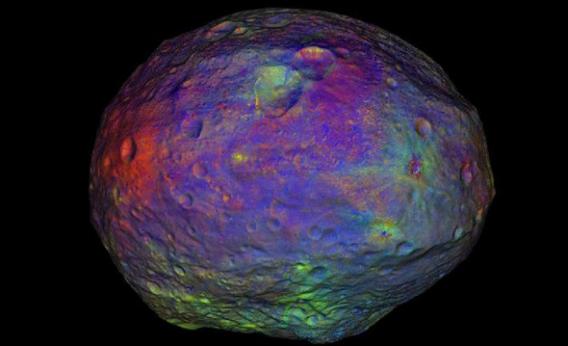Create a free profile to get unlimited access to exclusive videos, sweepstakes, and more!
The Mesmerizing Color-Dripping Dance of Asteroids

Alex Parker is an astronomer at UC–Berkeley, where he researches minor planets—asteroids, Kuiper Belt Objects (giant ice balls orbiting past Neptune), and more.
He’s also what I think of as a “data artist”, someone who can take data and turn it into art. This isn’t easy: It takes a deep understanding of the data and of the science to create something both beautiful and amazing. He’s done it before, showing what it would look like if all the exoplanets discovered by Kepler orbited one star, or what supernovae would sound like if converted to music, or turning the mini-eclipses of the exoplanets in the Kepler 11 system into a piano sonata.
Now he’s gone and done something both astonishingly beautiful and scientifically fascinating: He took the asteroids in the solar system observed by the Sloan Digital Sky Survey—more than 100,000 of them!—and created an animation showing their orbits, their relative sizes, and even their colors in the survey. The resulting video, “Painted Stone,” is simply wondrous.
The beauty of this is obvious. But there are deep scientific explorations displayed here when you look carefully. Please indulge me a moment to explain.
The vast majority of asteroids in the solar system orbit the Sun between Mars and Jupiter. We’ve known for a long time that they aren’t just scattered willy-nilly in that vast volume; when you examine them, you find many of the rocks are on very similar orbits. The orbit of an object can be defined by just a handful of characteristics called the orbital elements; these include how close the orbit gets to the Sun, the length of the axis of the orbit (the length of the longest diameter of an ellipse, called the major axis), its tilt with respect to Earth’s orbit, and a few other parameters.
Asteroids that have similar orbital characteristics are said to belong to the same family, and many such families are known. It’s thought that all these asteroids in one family may literally have the same parent! Some time in the past, a bigger asteroid suffered an impact from another asteroid, breaking off smaller rocks that then go off on their own orbits. If that happens, the shrapnel will have very similar orbits, though not exactly the same … which is what we see.
You can look at reams of numbers laid out in tables to see this, or you can take those numbers and turn them into something visual our brains can process more easily. When you look at Parker’s video, you really can see this. For example, the asteroids in the inner main belt are greenish but the asteroids farther out appear bluer/purpler. I’ll note the asteroids aren’t really those colors; what astronomers call “color” is the difference in brightness of an object in one filter versus another. So if an asteroid is brighter in the red filter than the blue one, it can be said to be “red” even if the difference is slight. For us astronomer types, color is a relative term when we use it scientifically.
Having noted that, you can see that hugging Jupiter’s orbit are reddish objects. Can you also see how there are two clumps of them, about a third of an orbit apart? Those are the Trojan asteroids, populations of rocks more or less held in place by Jupiter’s gravity. It’s a quirk of physics; when a big object (like Jupiter) orbits another more massive one (like the Sun), there are two points in the orbit (60° ahead and behind) that are gravitationally stable, like a dip in the road. Asteroids can collect there, and Jupiter is so big it has lots of Trojans. The Earth is smaller so we have far fewer; the first one (and only one known so far) is 2010 TK7, discovered by NASA’s WISE mission. I wrote about how this all works in an earlier post if you want the fun details.
Asteroid families are fascinating. They tell us the history of the solar system, because the distribution in sizes, colors, orbital shapes, and more give us insight into the impacts that formed them. Parker’s professional scientific work on this was fun to read; I didn’t know that there at least 37 distinct asteroid families orbiting the Sun. Those have always been defined using the orbital elements, but he showed that by adding color information from Sloan, the families could be even better defined. That helps astronomers by reducing false positives (asteroids that look like family members when they’re not), which in turn sharpens our ability to analyze them. When that happens, details pop out that were hidden before.
We’re in an age where we’re learning about asteroids incredibly quickly. My stance on this is public and very clear: good. We need to know more about them, not only for the pure joy of exploration and knowledge, but also because they sometimes get uncomfortably close to our own blue-green planet.
And as I’ve said many times before as well: There is a deep beauty in science, and it can be indistinguishable from art. I think Parker’s video makes that quite clear.
Tip o’ the dew shield to Sarah Hörst.














